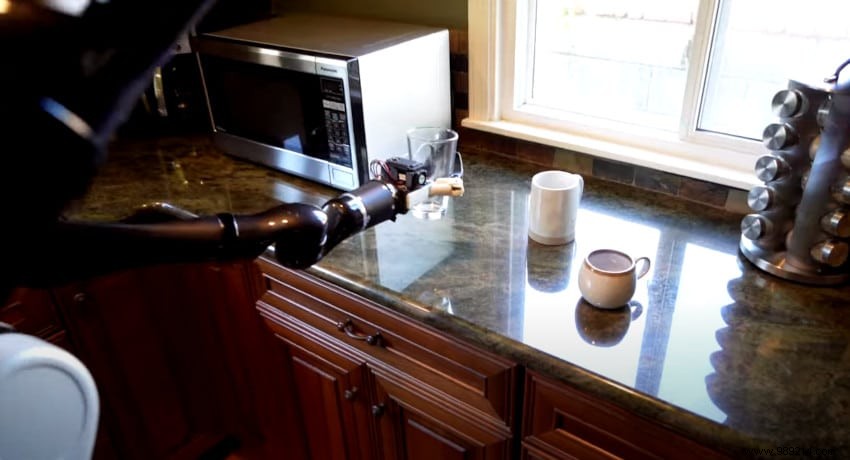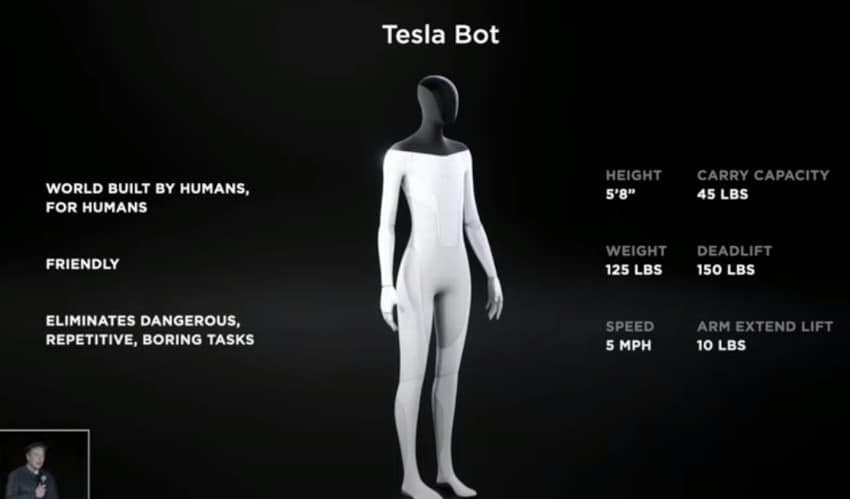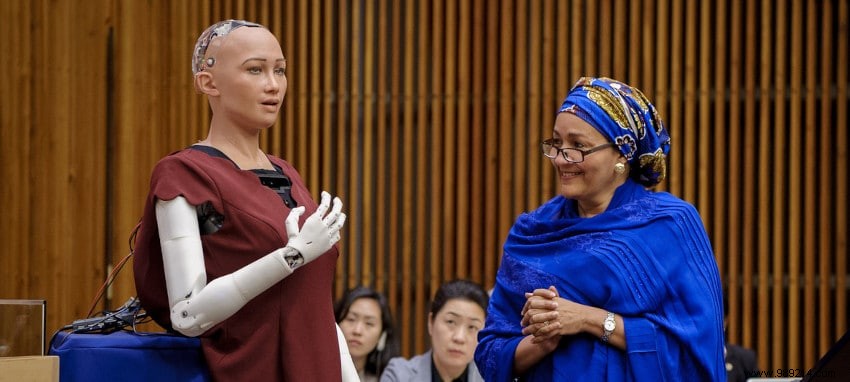To begin with, let's clarify the subject:these are not autonomous robot vacuum cleaners, nor shirt ironing machines or even robot lawn mowers, but humanoid-looking robots, which would interact with humans to assist them in their daily tasks (a bit like C-3PO in Star Wars). Storage, cleaning, laundry, meal preparation, all or part of the household chores could be assigned to it without the robot complaining. A dream for many, but will it ever come true?
It may well be so, according to the performance of Bot Handy, presented by Samsung at the Consumer Electronics Show 2021. The manufacturer is indeed working on a concept of a butler robot, not quite humanoid, but nevertheless equipped with an arm. articulated which allows him to carry out many tasks. The machine relies on an advanced artificial intelligence that allows it to recognize and pick up objects of all kinds, to fill the dishwasher, to set the table, to serve you a drink or to put away the shopping - in calculating each time the force necessary to manipulate all these objects.
The icing on the cake, this robot has a screen on which appear two eyes intended to make it more "endearing". “Our world is different and many of you have faced a new reality — a reality where, among other things, your home has taken on greater importance said Sebastian Seung, President and Director of Samsung Research, during the press conference associated with the event. Indeed, the health context and containment measures have led people to stay more at home, which has necessarily given rise to new organizational needs. Home assistant robots have perhaps never been as attractive as they are now.
The Toyota Research Institute (TRI) is also actively working on a humanoid robot concept. Its T-HR3 model, unveiled in 2017, is full of sensors that allow it to perfectly imitate all human movements. He too is able to "sense" what he is manipulating and adapt his strength accordingly. In June this year, the group announced that its robot now has new capabilities, which make it perfectly suited to the complex tasks inherent in the domestic environment. In particular, it is able to recognize and act on transparent surfaces, as can be seen in this video.

It turns out that transparent or reflective objects that are commonly found in a house (a glass or any other glass object, chrome or lacquered objects, etc.) disturb most robots. “To overcome this, TRI roboticists developed a new training method to perceive the 3D geometry of the scene while detecting objects and surfaces says Max Bajracharya, Vice President of Robotics at TRI. Thanks to improved sensitivity sensors, the robot is also able to properly grasp soft objects — typically a teddy bear lying around on the floor.
The Walker X robot developed by UBTECH Robotics is quite similar to the T-HR3 in terms of capabilities, but has a bit more "human" appearance. The latest upgrade to the machine, presented this summer, allows it to perform a much wider range of household tasks, such as serving tea, watering plants, wiping surfaces or handling household appliances (coffee machine , vacuum cleaner, etc.). Thanks to advanced motion algorithms, it can also adapt to complex environments (stairs, sloping or uneven terrain, etc.).
Although these robotic performances are impressive, we are still far from a convincing humanoid robot in terms of aesthetics and stability. On this point, the British start-up Engineered Arts has proven itself:its robot called Ameca is one of the most realistic humanoid automatons ever designed. Admittedly, it is devoid of legs and artificial intelligence and can only perform predefined movements for the moment. But the latter are imbued with an unprecedented realism, both in terms of body movements and facial expressions, as can be seen in the following video. Combined with an AI interface developed by a third-party company, it could really approach the image that we have of a humanoid domestic assistant.
Namely that Elon Musk also announced during the Tesla AI Day which was held in August, that he was currently preparing a prototype of a humanoid robot which could be ready as early as next year. This Tesla Bot, approximately 1.7 meters tall, could be capable of performing any repetitive and/or arduous task, in a domestic or professional context, such as carrying and moving objects (up to twenty kilos), shopping, etc. Tesla CEO clarifies that his robot will be "friendly" and will only move at 8 km/h - "which potentially allows it to escape if it becomes threatening jokes the businessman. This robot will be equipped with the Full Self-Driving present in the brand's cars and cameras similar to those that guide the Autopilot.

As promising as these different projects are, their large-scale commercialization is not for tomorrow. A number of experts see robotic assistants in our future, including Rob Coneybeer, co-founder of venture capital firm Shasta Ventures, reports Futurism , but not for at least 20 or 25 years. To begin with, although this type of product is a priori the subject of strong demand, it could be that consumers are not yet entirely receptive to it. In any case, the sector has never really taken off until now.
As proof, the Asimo robot developed by Honda. Presented for the first time in the year 2000 and considered the first robot to walk on two legs, this humanoid robot "the most advanced in the world" (according to the project site) had nevertheless evolved quite a bit:the latest version to date , presented in 2011, was able to navigate rough terrain, move at 9 km/h, open a bottle and pour a drink, and even speak sign language. However, it was never marketed and Honda officially ended its development in 2018. The manufacturer is now putting its technology to use in the brand's motorcycles and cars, as well as in rehabilitation devices used in physiotherapy. .
Similarly, the Pepper robot, introduced in 2014 by SoftBank Robotics (formerly Aldebaran Robotics), had mixed success. This humanoid robot, originally designed for professional use (customer relations), was able to recognize certain human emotions (from the facial expressions, tone and lexical field of its interlocutor) and to react accordingly. It was marketed for the first time in 2015, in Japan, as a companion robot:the first thousand robots sold out in a minute! It was then launched in Europe and the United States, serving as a host in certain companies and various public places. But in seven years, only 27,000 units were sold. In July 2021, faced with a drop in demand, SoftBank announces that it is stopping production.
Regarding Pepper, features deemed too limited and relatively frequent malfunctions could explain why the public did not ultimately adhere to the concept. The other projects appear more trustworthy, but it must be recognized that among the projects in progress - apart from that of Engineered Arts - few display a truly humanoid appearance, which, for some experts, remains fundamental. “A human form is often said to be useful because the robot can use the same tools and environment as a human, but another important reason is that humans find it easier to control humanoid-shaped robots said Tomohisa Moridaira, head of the T-HR3 development team, in a statement.
On this point, Hanson Robotics really stands out from its competitors. His robots really look like humans, their heads are even covered with a synthetic silicone skin, squishy and flexible. They are also capable of reproducing a wide range of facial expressions. His robot Sophia - famous for having obtained Arab citizenship in 2017 - is thus considered to be one of the most sophisticated humanoid robots ever built. Its neural networks would allow it to perceive a person's emotions based on the expression of their face and the timbre of their voice.
That said, some AI experts remain skeptical, arguing that it does little better than chatbots designed to formulate ready-made answers based on certain keywords. It was also not designed to perform household chores, but Hanson has released the cognitive robotics platform on which its robot is based to allow other teams to develop other applications and services.

Democratizing the use of a humanoid domestic robot will not be an easy task. The idea is attractive in theory, but it must be accessible to as many people as possible (financially speaking) and the investment must be really justified. A few years ago, Greg Shirakyan, an engineer at Microsoft Robotics, mentioned three possible reasons for the absence of domestic robots in our homes:1) our private environments are designed to be used by humans and not by machines; 2) the robot's lack of social intelligence; 3) the lack of a clear idea of what a home robot should look like.
It turns out that most household tasks considered useful today can already be taken care of by many connected devices. And while existing robot prototypes are indeed capable of multi-tasking, they are not completely autonomous either. How would an android vacuuming be more interesting than a "simple" robot vacuum cleaner?
Do robots have to look like us to do the job we want them to do? Are the public really willing to pay a large sum (the professional version of Pepper sold for 20,000 euros!) for a robot to serve them their orange juice every morning?
Apart from a real role of assistant, accompanying the elderly and / or people with reduced mobility, not sure that the public really wants to welcome a synthetic household help at home, at least for the moment. However, the day when such sophisticated machines, fully autonomous and performing all household tasks without a hitch, will be available (in about thirty years from now according to some experts), the discourse will be different.